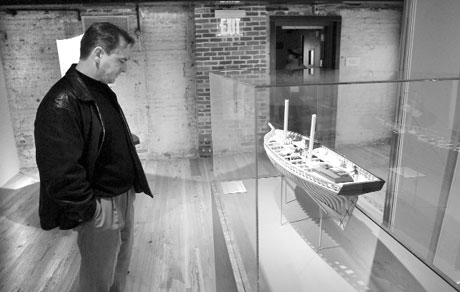By Elizabeth O’Brien
Visitors ahoy!
The South Street Seaport Museum opened some of its new galleries to the public on Friday, Dec. 12. But judging from the light turnout, few people realized there was an impressive gallery space nestled between the retail stores in the 19th-century buildings of Schermerhorn Row.
A handful of guests explored the galleries at midday on Friday, but the numbers thinned down to zero around 4:30 p.m.
Mario Bucolo, 36, an Italian tourist standing near the museum entrance, said he hadn’t heard of the museum when Downtown Express pointed it out around the five o’clock closing time. The editor of www.museumland.com, Bucolo greeted the discovery with the enthusiasm of a prospector finding gold.
“I can try now to make a very fast visit,” he said, hurrying towards the entrance, only to be turned away.
Bucolo said he was surprised that the new seaport galleries hadn’t come to his attention before. Bucolo said his unwitting neglect of the South Street Seaport Museum illustrated the very reason for his Web site’s existence.
“The problem that we try to solve with our portal—there’s a visibility problem” for smaller museums throughout the world, Bucolo said.
Bucolo vowed to do his part to raise the Seaport Museum’s profile. Museum staff could do as much. “Now open” signs hung on the doors, but they weren’t noticeable unless passersby were looking at the museum from up close.
Richard Stepler, the museum’s director of publications, said that the museum had not yet had a chance to put up many signs advertising the opening, but he said that the turnout struck him as good for the first day. Conroy Boxhill, a museum spokesperson, said that officials had planned a “soft opening” for Friday and that they would do more publicity in the weeks to come.
The museum’s inaugural exhibit, “Captive Passage: The Transatlantic Slave Trade and the Making of the Americas,” deserves a wide audience. Presented throughout seven galleries, it tells the story of slavery from the triangle trade, through the passage to the new world, to the emancipation of slaves and their legacy.
Artifacts on display include original and reproduced documents relating to the slave trade. One of the latter was a list of slaves and their prices, including, “A Negro man slave named Henry, $25,” and another, named Powell, for $200.
The galleries themselves seem part of the exhibit. Built between 1811 and 1812, the 24 galleries in the new South Street Seaport Museum lie on three uneven floors atop the Federal-style brick buildings on Fulton St. between Front and South Sts.
“It would be amazing if slaves didn’t work in these buildings,” Stepler said. Slavery was outlawed in New York State in 1827, he added.
“Captive Passage” is housed in seven of the 24 galleries. The remaining galleries will hold the museum’s permanent collection and are scheduled to open next fall.
Admission costs $8 for adults, $6 for seniors and students with a valid ID, $4 for children ages five through 12, and museum members at no charge. The price covers admission to all galleries in the new space, the three older galleries on Water and Fulton Sts., and tours of the permanently docked ships, including the Peking and the Wavertree.


































